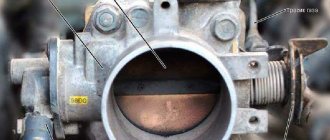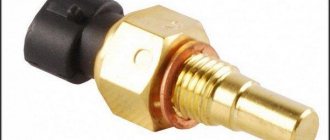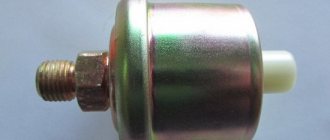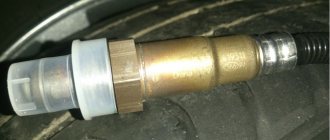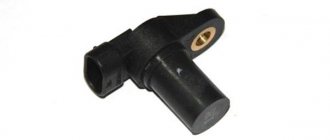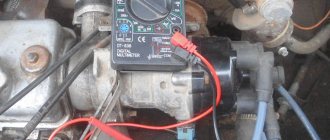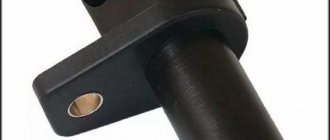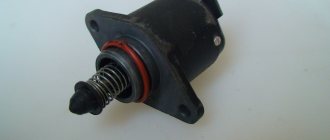In this article we will look at the phase sensor using the example of Samara (VAZ 2114-2115). It is worth noting that the phase sensor is one of the main sensors with which the controller calculates the operating parameters of the engine on Russian-made injection engines.
The phase sensor, or as it is called, the camshaft position sensor, is installed on eight and sixteen valve domestically produced cars with Euro-3 environmental standards.
What is a phase sensor used for and how does it work?
The camshaft position sensor determines the operating cycles of the internal combustion engine. The camshaft cams drive the valves, and the DF determines which valve is open. This is an integrated control unit, that is, it includes a sensitive element and a signal conversion system. There is a Hall element there - data is taken based on changes in the magnetic field.
The converter has a bridge circuit, a converter block, and an output stage. The work is that the DF determines the intake and exhaust phases of the 1st cylinder.
For carburetor engines it is not needed because the spark is supplied at the moment of compression and at the end of the exhaust gases. DPKV is sufficient for this.
Roughly speaking, the VAZ 2114, 2115 phase sensor functions as a fuel injection system. If it breaks down, the work of sparking falls on the crankshaft position sensor. The designs that are used on 16-valve cars differ from eight-valve ones.
Now let's try to explain in simple words how the phased injection system works. It turns out something like this: the DF gives a signal to the electronic engine control system (ECM), and it, in turn, gives a command to inject fuel, while the intake valve begins to open, and after it has opened, air is sucked in and mixed with gasoline to form a mixture.
Symptoms of a problem
The phase sensor of the VAZ-2115 car is the main component in determining the ignition timing. It is responsible for the precise timing of fuel injection.
If this node malfunctions, the following happens:
- fuel consumption increases;
- problems arise when starting a cold engine;
- dynamics and acceleration from a standstill disappear;
- stability of idle speed disappears.
The dashboard can confirm a malfunction of the DPRV by notifying you with an error code:
- 0340 means no signal from the DPRV. The cause may be a malfunction of the sensor itself or the electrical wiring.
- 0343 means an increased signal supplied by the ECU. The cause may be oxidation or damage to one terminal.
In order to operate the car to the fullest of its capabilities, it is necessary to clearly monitor the condition of the components responsible for ignition and fuel supply.
How to check phase sensor 2114
You can check the sensor using a voltmeter. Below are several options for checking phase sensors.
Checking the phase sensor 21110-3706040
It is necessary to set the voltage on the voltmeter V1 on the power supply E to 13.5 ± 0.5 V, the voltage at contact “B” of the sensor must be at least 0.9 Up.
Next, we bring the plate to the end of the sensor and look at the operation of the sensor. It should work. This can be determined on contact B. When the sensor is triggered, the voltage on contact “B” should be no more than 0.4V.
We remove the steel plate from the end of the sensor and measure the voltage again, it should change to a value of at least 0.9 Up.
Checking the phase sensor 21120-3706040
Set the voltage at voltmeter V2 on power supply E to 13.5±0.5V, the voltage at contact “B” should be no more than 0.4V.
Bring a steel plate made of soft magnetic material with a width of at least 20 mm, a length of at least 80 mm and a thickness of 0.5 mm to the end of the sensor as shown in the figure, placing it in the slot of the housing. The voltage at contact “B” of the sensor must change and be at least 0.9 Up.
Remove the steel plate, and the voltage at contact “B” of the sensor should change to a value of no more than 0.4V
Verification methods
The DPRV of the VAZ-2115 car is located under the air filter, installed near the cylinder head. In order to check its functionality, it is necessary to remove the power socket and dismantle the part.
Visual inspection
The first way to check the performance of the DPRV is a routine external inspection. The causes of the malfunction are the following:
- Cracks and chips on the body can cause penetration. A complete replacement of the part is required.
- Oxidation or breakage of contacts in the connecting socket is the reason for the lack of connection between the DPRV and the ECU. Cleaning the contacts will fix the problem.
Checking with a multimeter
In order to check the phase sensor with a multimeter, you must:
- Dismantle the part.
- Connect the multimeter terminals to terminals 1 and 3 of the sensor.
- Place the device in the resistance determination position.
- Apply a metal screwdriver or knife to the tip of the DPRV.
The device should react to metal, and the multimeter should show the working resistance of the part. Lack of response indicates damage.
Checking with a voltmeter
To check you need:
- Dismantle the part without removing the current-carrying socket.
- Turn on the ignition.
- Connect the voltmeter terminals to terminals 1–3.
- Bring a metal object to the tip of the part.
A working part should react to metal and produce a voltage of 0.7 to 0.9 V. High readings or their complete absence indicate damage.
How much does a phase sensor cost?
Depending on the manufacturer, the cost of the sensor varies. Before you think about replacing the sensor, you need to remove and see which sensor you have installed from the factory.
- Phase sensor /2110/ (distribution) 8 cells. (v 1.5) (Autoelectronics Kaluga) from 250 rub.
- Phase sensor /2110/ (distribution) 8 cells. (v 1.5) (BAUTLER) price from 300 rub.
- Phase sensor /2112/ (distribution) 16 cells. (v 1.6) (Autoelectronics Kaluga) from 300 rub.
- Phase sensor /2112/ (distribution) 16 cells. (v 1.6) (BAUTLER) price from 250 rub.
Replacement
Replacing a damaged camshaft position sensor is very simple. To do this you will need:
- Allow the engine to cool for an hour.
- Remove the “−” terminal from the battery.
- Remove the power socket.
- Unscrew the mounting bolt.
- Remove the sensor from the hole.
Installation of the new part should be carried out in reverse order. After completing the replacement, you need to start the engine, warm it up, and perform a test run of the car.
Long-term and reliable operation of the vehicle can only be ensured by original spare parts. The original phase sensors for the VAZ-2115 car have the factory part number 550488 (for 8 valve models).
How to replace a phase sensor with your own hands
If you are absolutely sure that the phase sensor is faulty, you can replace it yourself. It is located at the end of the cylinder head next to the air filter.
Replacing the phase sensor begins by disconnecting the power from the battery. In this case, the control unit memory will be reset.
If this is not done, it will continue to operate in the same mode as with a faulty phase sensor. Normal operation will begin after a few engine starts.
The tool that will be needed is just a ten key and sealant. Next, disconnect the wires from the phase sensor and remove it using a key.
The new sensor needs to be coated with sealant, the layer should be small, and it should be left for about five minutes before installation. We install it on the seat and connect the wires.
Next, connect the battery, start the engine and see if the check engine light comes on. If it no longer lights up, then the sensor is installed correctly.
Camshaft sensor
DPRV is otherwise called a phase sensor. The main task of this part is to accurately determine the position of the shaft when the engine is running. The definition is based on the interaction with the engine flywheel gear. The flywheel is missing 2 teeth on the outer edge. It is this gap that the DPRV is responding to. Having passed the moment of rupture, the sensor sends a signal to the control unit. The ECU interprets the signal as determining the exact position of the crankshaft, as well as the piston group, and injects fuel into the combustion chamber.
Lada › Logbook › 22. Replacing the camshaft sensor
Good day!
Today I got around to replacing this phase sensor) It all started in the summer, the “Check” started to light up periodically and I thought of buying a BC so as not to spend money on diagnostics, after buying the BC I found out that the phase sensor was rosining the brains.
Phase sensor
, this is a thing that, if it malfunctions,
increases fuel consumption by 10-15%
of normal.
Catalog number of the sensor for the 1.5 8v engine 2111-3706040-00
the last 2 digits are the manufacturer.
I decided that it was time to change it, otherwise the burning “check” was already annoying, and the passengers hesitated to ask what was wrong with the engine))
Actually, there are no problems with replacement, the work lasts for 5-10 minutes maximum
.
At the moment my consumption was 9.6, I had already driven more than 100 km and the consumption remained the same. (consumption in the city)
Replacing the sensor:
1)
Remove the terminal from the battery
2)
Remove the contact from the sensor itself
3)
Unscrew the bolt from the sensor
4)
Pull out the sensor
Reassemble in reverse order
Well, no way without photos)
And a couple of photos with BC data
And as usual, he was seen with a traffic violation. Not only is it basically impossible to turn there, he’s also in the oncoming lane and on a double solid road) when he passed the intersection, I saw in the mirror that he drove there then)
Any questions?) ask)
Price: 285 ₽ Mileage: 65,909 km
Fuse box diagram and location on VAZ-2114, 2115 and 2113
Remember one important thing, before you start disassembling the stove, wiper, headlight or anything else - make sure that the fuse responsible for this circuit has not blown
